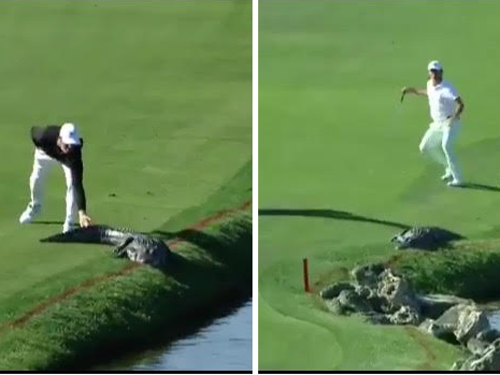During this weekend’s Arnold Palmer Invitational at Bay Hill Club and Lodge, we saw a potentially dangerous situation handled two very different ways. There are the usual suspects that make the golf course their home, but at Bay Hill Club and Lodge, their wildlife is a little more exotic than what you may have at your course here in Colorado. During the first round, Cody Gribble saw an opportunity to have a little fun with an alligator catching sun while laying by a pond. The frightening/amusing part is that Cody really didn’t even have to go very far out of his way to get some interaction from the alligator. It wasn’t like the alligator was laying off to the side, deep in a water hazard. The alligator was laying on a red lateral water hazard line on a part of the course that players walk right by to get to their next shot. You can see this is evident by the picture (above, right) when Smylie Kaufman absentmindedly walked right up on the alligator as he was making his way to the putting green. His quick reaction to seeing the alligator that close was how I’m sure most of us naturally would react.
Those interactions bring up an interesting situation in the Rules. How do you play your ball as it lies when there is a potentially dangerous situation near your golf ball? As I had mentioned earlier, this alligator was on the red lateral water hazard line. This also means that this alligator was laying on a part of the course that was through the green and very much in play.
The general principle in the Rules is to play your ball as it lies, but the Rules are not so unflinchingly rigid that they do not provide relief without penalty from a situation that could cause a player harm from an outside agency. The Rules give us some clarification in decision 1-4/10. In this decision, the Rules use a more common (but equally as frightening) situation in which a player’s ball is close to a live rattlesnake or active bee hive. The decision, in part, says:
“It is unreasonable to expect the player to play from such a dangerous situation and unfair to require the player to incur a penalty under Rule 26 (Water Hazards) or Rule 28 (Ball Unplayable), although these Rules remain an option, if applicable.
If the ball lay through the green, the player may, without penalty, drop a ball within one club-length of and not nearer the hole than the nearest spot not nearer the hole that is not dangerous and is not in a hazard and not on a putting green.”
It’s an interesting situation in the Rules because there is a large degree of judgment and personal comfort built into this decision. The Rules try and be as black and white as possible when detailing non-specific verbiage. A good example is decision 27-2a/1.5 when outlining how far a player may “go forward to search” for the original ball (it is considered a “short distance” and then even assigned a leash of about 50 yards). But here the decision does not outline what distance that may be. It simply states that a ball (Notice how they are allowing you to substitute a ball when taking relief. The fact that you need to invoke this decision in the first place means you should not have to get close enough to retrieve the original ball) must be dropped within one club-length of the nearest spot that is not closer to the hole and not dangerous. The distance of how far away to drop is always in flux depending on what the player considers dangerous. So for Cody Gribble, it seems that this distance could be a lot shorter for him than what it may be for Smylie Kaufman.
I will say that for a Rules Official, there should be some degree of judgment if you are granting a player relief in this situation. If a player is trying to get 150 yards away to get to the other side of a fairway for a great angle into the putting green, I would ask the player some questions as to why they think that is the nearest “not dangerous” point.
The decision also goes into detail about how to proceed if the ball lies in a hazard, in which case you would proceed as described above except that a ball must be dropped in the hazard. If this is not possible, under penalty of one stroke, the player may drop outside the hazard keeping the point where the original ball lay between the hole and the spot on which the ball is dropped. If interference by anything other than the dangerous situation makes the stroke clearly impracticable or if the situation would be dangerous only through the use of a clearly unreasonable stroke or an unnecessarily abnormal stance, swing, or direction of play, the player may not take relief as prescribed above, but he is not precluded from proceeding under Rule 26 or 28 if applicable. If this situation occurs on the putting green, the player may place a ball at the nearest spot not nearer the hole that is not dangerous or in a hazard.
Hopefully you’ll never have to utilize this decision, but the Rules are prepared on how you should proceed.


